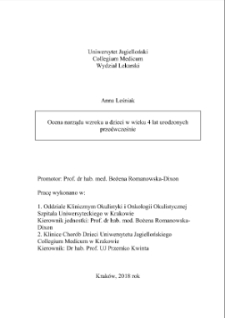Object
Title: Ocena narządu wzroku u dzieci w wieku 4 lat urodzonych przedwcześnie
Abstract:
Cele pracy: Głównym celem pracy jest analiza przyczyn zaburzeń widzenia i percepcji wzrokowej u dzieci w wieku 4 lat urodzonych przedwcześnie. Materiał i metodyka: W badaniu wzięło udział 82 dzieci w wieku 4 lat, przedwcześnie urodzonych. U pacjentów wykonano badanie okulistyczne, badanie wywołanych potencjałów wzrokowych, rezonans magnetyczny oraz badania psychologiczne. Dla celów pracy wykorzystano również dane z historii choroby takie jak: płeć, masa urodzeniowa, wiek płodowy, skalę APGAR, występowanie krwawienia dokomorowego, leukomalacji okołokomorowej i dziecięcego porażenia mózgowego oraz czas trwania tlenoterapii. Wyniki i wstępne wnioski: Z naszych obserwacji wynika, że najważniejszym czynnikiem wpływającym na ocenę okulistyczną jest retinopatia wcześniaków wymagająca laserokoagulacji. Uzyskane wyniki mogą wskazywać, że u niektórych wcześniaków z ROP leczonych laserokoagulacją istnieje uszkodzenie przewodnictwa w drodze wzrokowej. Ponadto, można stwierdzić, że zmiany w zapisie nie zawsze związane są z obecnością retinopatii i przeprowadzonej laserokoagulacji. Na tej podstawie można postawić hipotezę, że zmiany w zapisie VEP mogą wynikać z niedojrzałości układu nerwowego u dzieci przedwcześnie urodzonych. W kolejnych badaniach zauważyliśmy znamienną statystycznie korelację pomiędzy widzeniem stereoskopowym a zaburzeniami w mikrostrukturze istoty białej. Związek pomiędzy ; frakcyjną anizotropią w ciele modzelowatym a percepcją wzrokową sugeruje istnienie złożonego modelu komunikacji pomiędzy półkulami mózgu i jego znamienny wpływ na drogę wzrokową.
Place of publishing:
Level of degree:
Degree discipline:
Degree grantor:
Promoter:
Date issued:
Identifier:
Call number:
Language:
Access rights:
Object collections:
Last modified:
Mar 13, 2023
In our library since:
Jun 25, 2020
Number of object content hits:
5
Number of object content views in PDF format
0
All available object's versions:
http://dl.cm-uj.krakow.pl:8080/publication/4349
Show description in RDF format:
Show description in OAI-PMH format:
| Edition name | Date |
|---|---|
| ZB-130898 | Mar 13, 2023 |
Objects
Similar
Leśniak, Anna
Biedroń, Agnieszka
Hobot, Justyna
Grudzień, Andrzej
Szymońska, Izabela
Pobiega, Monika
Grabska, Natalia

